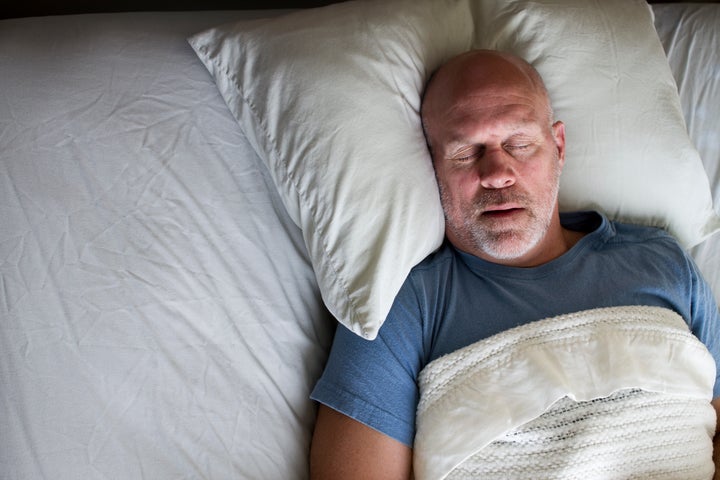Sleep apnoea is a “very serious affliction” and it appears to be on the rise, with the number of tests carried out to diagnose people across England doubling in the past 10 years.
People with the condition experience regular paused breathing episodes over a long period of time while asleep. Sufferers can experience anywhere between five and 100 pauses an hour (the latter is considered very severe).
Official statistics suggest those who go undiagnosed could experience a 20% reduction in life expectancy, which is why it’s incredibly important to get diagnosed and treated.

What is sleep apnoea?
Sleep apnoea is a relatively common condition, which occurs when the walls of the throat relax and narrow during sleep.
“It happens as the muscles of the neck and throat relax and the jaw drops, which makes the tension in the windpipe decrease,” Dr Helen Webberley, a GP who runs the online healthcare service My Web Doctor, told HuffPost UK.
“The obstruction reduces the oxygen intake, but this never becomes critical, as it wakes you as the body realises it needs a bit more oxygen.”
Not only can sleep apnoea lead to poor quality of life in the longterm, but it can also put people at risk. Road accidents are a very real (and common) threat for sleep apnoea patients, said Chris Rogers, managing secretary of the Sleep Apnoea Trust.
The sleep condition affects approximately 5% of population - 6% of men and 2% of women - and, Rogers noted, appears to be rising due to the obesity crisis.
It typically affects men with a collar size of 17 inches or more and early menopausal women who put on weight. It can also be worse in people with big tonsils and adenoids.
“The condition has been linked to health problems including increased blood pressure, Type 2 diabetes, depression and - because of the strain on the heart from stopping breathing - there can be cardiac issues,” Rogers added.
Symptoms of the sleep condition
It can be very difficult for single people to determine whether they have sleep apnoea or not, as it’s usually first spotted by a partner, friend or family member.
The most common symptoms include:
:: Loud snoring
:: Noisy and laboured breathing
:: Repeated short periods where breathing is interrupted by gasping or snoring
Rogers, 70, who was diagnosed with sleep apnoea in 2000, described a typical sleep cycle as: “The oxygen level drops in your blood, the brain asks ‘what the hell is going on?’, you wake up from a light sleep and then drift off again - and it repeats.”
The disrupted sleeping pattern is not only bad news for the body, but it’s also terrible news for your quality of life.
“You wake up feeling unrefreshed. This is because you only ever have light sleep, meaning you don’t get the proper sleep required,” explained Rogers.
“As a result you nap throughout day, perform badly at work and feel tired all the time. It’s also very dangerous if you drive as you could fall asleep at the wheel.”
According to the DVLA, sleepiness contributes to up to 20% of motorway accidents and also increases the severity of an accident, as driver reactions are impaired.
Diagnosis
If you think you may have sleep apnoea it’s important to consult your doctor.
“Your GP will have a chat with you and the most common route then is to refer you to an NHS sleep clinic,” explained Rogers.
“There you will undergo a sleep test. This can involve a home test where you get sent the kit so you can record what goes on when you’re asleep.
“You then send the device back and your sleep data is downloaded by a consultant who will look at the results and decide whether you have a problem.”
Treatment
There are two main avenues for treating the condition - one is through lifestyle changes (such as losing weight, stopping smoking and limiting alcohol intake) and the other is via continuous positive airway pressure (CPAP) treatment.
Rogers described the latter as an “incredibly effective method”.
A CPAP device is a small pump which delivers a continuous supply of compressed air through a mask that either covers the nose or the nose and mouth. The compressed air prevents the throat closing when a person sleeps.
“The machines are very sophisticated,” explained Rogers. “I’ve been using a CPAP machine for 16 years and I probably wouldn’t be alive if I hadn’t been on it.”
He said he felt instantly different when he first started using a CPAP machine following his diagnosis 17 years ago.
“Before I would fall asleep in meetings all the time,” he recalled. “In January 2001 I went onto a CPAP machine and my life changed.
“I wanted to get up and attack the day instead of feeling like I couldn’t even get out of bed to go to work.”
Of course, there are some downsides to CPAP usage. The mask is obviously quite large and inconvenient, it can also dry out your airways. However this can be prevented with the use of a humidifier, which can be added on to the machine and helps retain moisture in the nasal passages and throat.
According to the NHS, there is also an option to have surgery to treat sleep apnoea, however it “isn’t routinely recommended because evidence shows it’s not as effective as CPAP and it also carries the risk of more serious complications”.
Summarising his thoughts on CPAP treatment, Rogers said: “It’s inconvenient, it’s not sexy, but it’s life-saving.
“And treatment with it is free on the NHS.”